Split system for 2 rooms: how the equipment is designed and works + nuances of choosing such equipment
If you need to cool two rooms, but there is only one place for an external unit, the optimal engineering solution will be a split system for 2 rooms - the equipment is especially relevant for new high-rise buildings, where parts of the facade, decorated with special baskets, are allocated for air conditioners.
What is the principle of operation of a “double” split, what are the advantages and disadvantages of the scheme, and also how much does such a system cost? We’ll look at it in the article. In addition, we outlined the main parameters for choosing an air conditioner and described the specifics of its installation and maintenance.
The content of the article:
Relevance of a “double” split system
In the private sector, there are usually no problems with installing several devices for different rooms. But if the owner does not want to spoil the facade with several bulky boxes, it also makes sense to consider a multi-split.
Business-class high-rise buildings are equipped with centralized systems, so the issue of air conditioning for an individual apartment is removed. In other cases, the installation of climate control equipment must comply with certain rules.
Dimensions of installed suspended units, for example, duct or cassette systems, limited by ceiling heights. A quota has also been set for the total energy consumption in the apartment, which regulates the power of the supplied electricity. But most of all the rules concern external blocks.
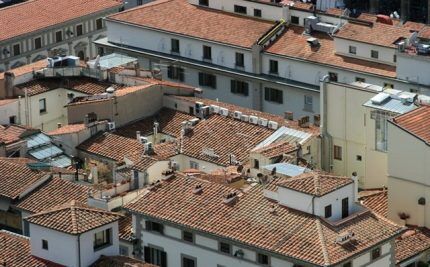
The installation of climate control equipment on the façade and outside of some buildings is prohibited by law or individual operating rules. But residents are offered designated places for such purposes on the balcony, roof, technical floor, and in special niches.
For small venues, square meters are not enough. One apartment is usually allocated only one space measuring about 60 cm by 1.5 m. The most expedient solution in this case would be to install a simplified multi-split system.
Operating principle of the equipment
What is the difference between this split systems, if you compare it with a regular air conditioner? The peculiarity is the triple division of the freon circuit.
First part is located in the external block and consists of a compressor, flow dividers, and a condenser heat exchanger. The latter has 2 sections.
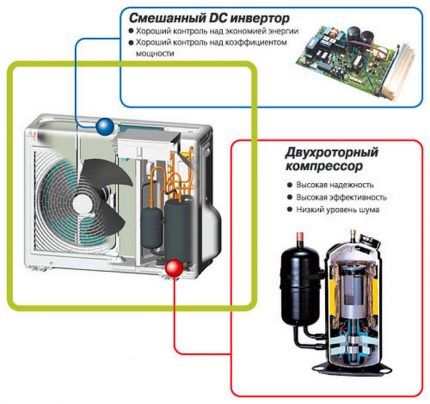
The other two parts are located in indoor units and consist of evaporators and capillary tubes. All participants in the scheme are connected to each other by freon lines.
The operation of this scheme is based on the property of liquids that can absorb heat during evaporation, but, on the contrary, release it during condensation. The agent in refrigeration systems is freon, which circulates in the circuit.
Heat is absorbed by the indoor units and sent to the outdoor unit due to the thermodynamics of the agent's transition from liquid to gas and back.
Hot freon leaves the compressor under pressure and runs into the separator, where it splits into two to cool two rooms. Once in the evaporator, freon will have to transition to the gas state. Why does it take heat from room air, which is pumped by a fan.
Next, the freon is sent to the condenser heat exchanger (also 2 sections), where it is cooled to a liquid state.
In this way, the process of cooling the premises occurs. But the equipment can also work for heating. In this case, the direction of movement of freon changes.
Features of the functioning of air conditioners
It is technically possible to connect up to 7 internal boxes to one outer box. There are no clear connections between the power of the outdoor unit and the number of indoor units. One external person can work in a company with either two or three internal ones.
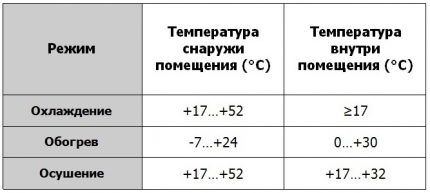
Conventional multi-splits differ from expensive and advanced multi-zone installations by the inability of indoor units to operate in a heat-cold pair.
They can function only in one climate direction - either all for cold, or all for heat. If you turn on the units in opposite modes, the equipment will not start.
But you can set different temperatures on each device. But you need to stay within one mode - either cooling or heating.
Selecting an installation based on characteristics
There is an opinion that a double split system should cost less than two separate appliances, but this is not true. Compared to the total price of two installations, one double installation will be 15-30% more expensive, even with the same power.The reason is the inverter operating principle.
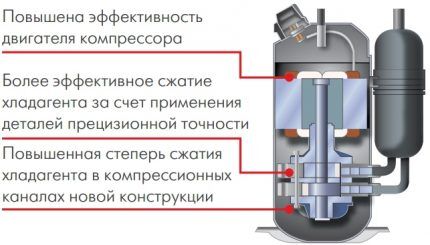
Non-inverter air conditioners are cheaper and can be equipped with a winter kit. But there is little such equipment in the product range of manufacturers due to low demand.
Three types of indoor units
Internal modules of cassette, channel or wall type can be connected to the external unit. Let's consider when and in what rooms they are used.
Cassette unit not suitable for rooms with low ceilings and/or small areas. These models are designed for large commercial premises - offices, restaurants, shops, cinemas.
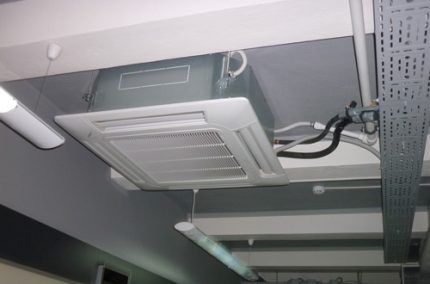
Duct wiring also involves reducing the height of the rooms. This option is the most aesthetic, albeit expensive.
It would be appropriate in a country cottage, but not for two rooms, but for several rooms. You can make a common wiring with one or two external units.
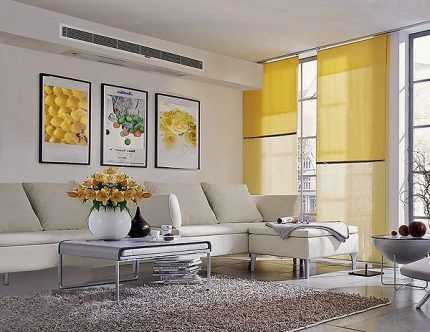
Wall blocks - the optimal solution for an ordinary apartment or house with standard ceilings. They are easy to install and do not require large premises.
Technical parameters of devices
External units in double split systems are more reliable and the total length of their routes is longer when compared with conventional ones.
Indoor units are selected according to:
- power;
- range of outdoor temperatures;
- set of functions;
- length of communications;
- appearance.
The main functional parameter is the range of outdoor temperatures. It is important that the equipment operates in conditions that are below the maximum permissible. The efficiency of the equipment depends on the atmospheric load.
It is also important to consider the following three parameters:
- Corrections for additional heat inflows. Often, these coefficients require different indoor units for different rooms.
- Outer box power, which should be equal to the total cooling capacity of the indoor units plus correction factors. The outdoor unit may have 3 or 4 ports for connecting freon pipes, but only 2 are needed.
- Measurements of the maximum length of all freon pipes to internal blocks: each individually and the total number.
The disadvantages of the design include the need to install internal devices close to each other - next door. The distance depends on the length of the route in the selected model.
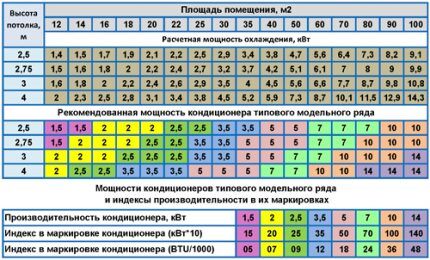
There is also a simplified formula: at 10 m2 you need about 1000 watts of power. This calculation works for rooms with good thermal insulation. If the light enters the room from the south or southwest side, add another 25% to the indicators.
Detailed instructions for calculating split power are presented in this article.
Manufacturers and models
The most reliable manufacturers Japanese companies are traditionally considered Fujitsu, Mitsubishi, Toshiba. They are also the most expensive brands.
The average price category is Chinese General Climate and Japanese Daikin. Budget series - Chinese Hisense, English-Chinese Dantex.
Of the 2-room models, you can consider the following:
- Mitsubishi Electric MSZ-HJ25VA-ER1×2/MXZ-2HJ40VA-ER1: at 50 m2 with deodorizing and anti-allergenic filter, low noise level of 20 dB, night mode.
- General Climate GC-M2E18HRN1: at 53 m2, there is a mode of ventilation, self-diagnosis, drying, but there are no fine filters.
- Electrolux EACS/I-07HP+EACO/I-14 FMI-2: at 40 m2, economical energy consumption, heating operates at temperatures down to –15 degrees.
- Fujitsu Inverter AOYG14LAC2: an external unit that can be completed with budget internal ASYG07LMCA (15 m2) or designed for a large area ASYG07LUCA (20 m2) and ASYG09LUCA (25 m2).
- Hisense AMW2-20U4SNC1/AMS-09UR4SVEDB6x2: at 50 m2, two-way condensate drain connection is provided.
- Dantex RK-2M24SEGE: at 70 m2, there is a system against ice formation, but it works for heating at temperatures down to –7°C.
The product lines include fixed and dial systems. The first ones imply a complete set from the manufacturer. In the second case, you can select the blocks yourself.
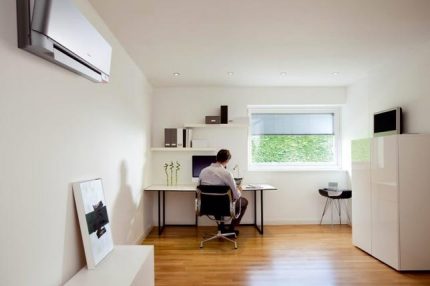
Specifics of installation and operation
If you compare the cost of installing two separate air conditioners and a double split system, the amount will be approximately the same. The reason is the similar length of the tracks. The price of installation directly depends on the length of interblock connections, cables, freon tubes.
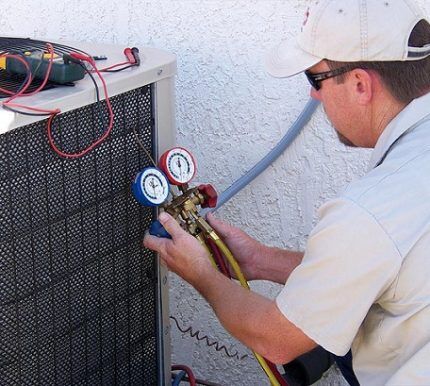
When Installation of air conditioner carried out under general repair conditions, it is advisable to split the installation of the split system into 2 stages.
First, groove the walls, install inter-block communications, secure the outdoor unit, and work on the internal equipment after the finishing of the premises.
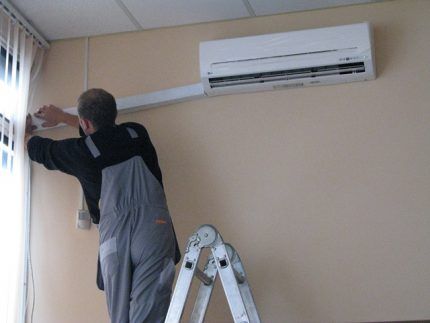
It is better to place the outdoor unit on the facade under the window so that the technician has access to it during maintenance.
Operational features of the split system:
- The outdoor unit operates at full power even if the air conditioner is turned on in only one room. This increases the energy consumption per device.
- Two devices cannot operate simultaneously for heat and cold. But if the system supports ventilation mode, you can turn on heating in one room and set ventilation in another.
- If one outdoor unit breaks down, two rooms will be left without air conditioning.
Indoor units, regardless of their number, need to be arranged periodic sanitation.
Mold on the evaporator fins and fan turbines reduces the performance of the device by half and contributes to the appearance of an unpleasant odor.
Conclusions and useful video on the topic
What is multi-split. Block arrangement diagram. Features of installation work.
Installation of the system in 2 stages - before and after repair.
If there is no possibility or desire to install two separate air conditioners, it makes sense to choose a split system for two rooms. Important parameters when choosing are power, temperature range, length of freon pipes, height differences between blocks.
Share with readers your experience of choosing and using a split system for two rooms. Please leave comments, ask questions about the topic of the article and participate in discussions - the feedback form is located below.




The disadvantages of a split system are significant enough to not be taken into account when choosing. An inexpensive system has a shorter service life and fails more often. Especially with inept installation and untimely maintenance. A breakdown of the compressor of the outdoor unit usually leads to a complete replacement of the equipment, so it is wise to immediately opt for split systems from among the expensive ones.
I will surprise you, Sergey, with the average service life of air conditioners:
— economy class (cost less than ₽20,000) – 10~15 years;
— premium class (cost 21000~35000) – 15~20 years;
- luxury (cost ≥ 36,000) - can last ≥ 20 years.
In other words, by entrusting installation to professionals, you can use an inexpensive air conditioner for 15 years without overpaying 10,000~15,000 thousand.
If the compressor of the outdoor unit breaks down, the compressor will have to be replaced, but why do the rest?
We have a new building, and the management company allowed us to install air conditioning on only one of the facades, so as not to spoil the appearance of the house. This, of course, may be correct, but not entirely.There are no problems for one-room apartments, but we have a three-room apartment: two rooms have windows on opposite sides. We didn’t know that there was such an air conditioner for 2 rooms, so we took one powerful one to treat 2 rooms. But this is very inconvenient; you have to constantly keep the doors open. And in one room it is very cold, and in the second it is more or less comfortable.
Good day, Sergey. Invite the technician who installed the split system for you and ask him to work out a diagram for parallel connection of two indoor units located in different rooms. Attached a screenshot of a single-line diagram (did not show the supply/return cold pipe).
It is clear that the maximum possible length of the “pipes” plays a role (a 15~30-meter separation of the indoor and outdoor units is usually allowed), and the system will need to be refueled. The only inconvenience is that you will have to clearly monitor the alternating operation of the indoor units (when the unit is working in one room, the other must be turned off and vice versa).
That is, as far as I understand, this double connection method only works if two indoor units are placed in adjacent rooms where the windows face the same side, correct?
Hello. This is more profitable for the owner himself, but is not a necessary condition when installing a split system in two rooms. If the indoor units are located in adjacent rooms, then it is easier and cheaper to lay communications between them.
In fact, you can install a multi-split system in more rooms.And it is best to install such systems before final repairs, since the finished repairs will have to hide communications in boxes. But it is more practical to make grooves in the walls for laying communications.
Good afternoon I have had a gree multi-inverter air conditioner for 9 years. For three exits, yes. and now the electronic car has deteriorated for the second time. responsible for the compressor. There are three electronic cards in total on the electronic board. Due to the very expensive cost of the electronic card: about 500 dollars, I decided to throw out this multi-inverter air conditioner and install regular ones. Do non-inverter air conditioners exist in nature but have two outputs?